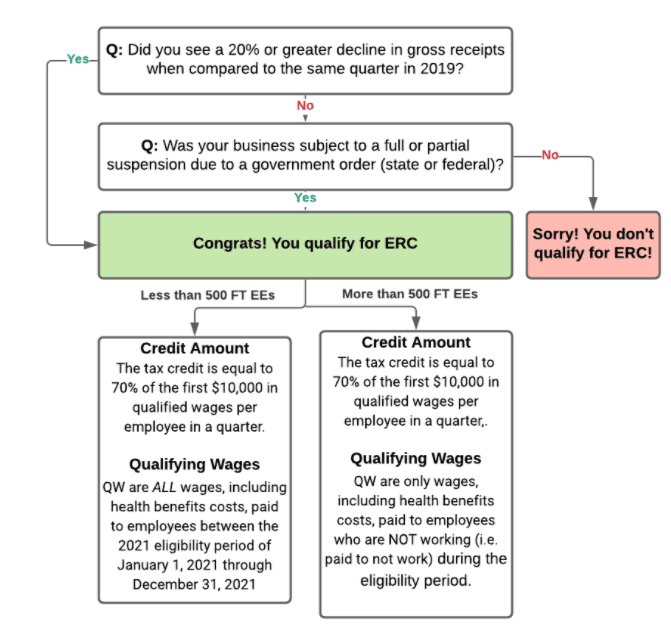What is the Employee Retention Credit?
Did you know? The Employee Retention Credit (or ERC) provides businesses with another source of financial relief. If you answered ‘no', you're not alone. According to a recent study, only 39% of small businesses were even aware of this payroll tax credit.
If you're looking to save dollars wherever you can, or want to maximize the financial relief available to you, keep reading this post to learn more.
What is ERC?
Each pay period, employers withhold a certain amount of an employee’s earnings—called qualified wages. This money is for federal unemployment (or FUTA) tax. Payroll tax credits—like the Employee Retention Credit—let businesses keep some of this money by reducing the federal taxes they have to pay. If you're looking to save dollars wherever you can, the Employee Retention Credit is one method to leverage.
Example: If your quarterly payroll tax bill is $15,000 and you’re eligible for an $8,000 tax credit, your tax payment will be reduced to $7,000. If your tax credit is $15,000 on a tax bill of $12,000, you can get a $3,000 check.
Is my business eligible for ERC in 2021?
There are two main ways to qualify for the Employee Retention Credit. You may qualify if your business has been subject to a partial or full suspension due to a government order (federal or state). Or, you may qualify if you've seen a drop in gross receipts* compared to 2019 by 20% in 2021.

What is the tax credit amount?
If you qualify for this credit for 2021, you can receive up to $7,000 per employee per quarter in 2021. The amount of the tax credit is equal to 70% of the first $10,000 in qualified wages per employee per quarter in 2021. This includes the cost of offering health benefits to employees.
That said, the maximum credit amount for 2021 is $14,000*, which is almost 3x the 2020 maximum of $5,000.
* Recently, the American Rescue Act extended the Employee Retention Credit until December 31, 2021. We’re awaiting guidance to see if that translates into a maximum 2021 credit of $28,000 (no certainty yet).
Does the size of my business matter?
The definition of “qualified wages” depends on the size of your business.
- For employers with less than 500 employees: Qualified wages* are ALL wages paid to employees in 2021, whether they are working or not.
- For employers with more than 500 employees: Qualified wages* are only wages, paid to employees who are NOT working. What does “paid to not work” mean?
Here is an example: Mike is the owner of a large restaurant that has three locations and 600 employees. During the government shut down, Mike could only have some of his staff at work. However, he opted to pay the wages and healthcare benefits to employees he had to furlough. In this scenario, “qualified wages” are the wages and benefits Mike paid to furloughed employees.
* Qualified wages includes the cost to provide health benefits to employees
Am I eligible for ERC if I received a PPP loan?
Yes, businesses that received a PPP loan are eligible to claim the tax credit. However, you can only claim the Employee Retention Credit on any qualified wages that are not counted as payroll costs when you for obtaining PPP loan forgiveness.
For example: Wages that were paid with PPP loan proceeds that were forgiven or expected to be forgiven cannot also be used to substantiate an Employee Retention Credit claim. Any wages that could count toward eligibility for the Employee Retention Credit or PPP loan forgiveness can be applied to either of these two programs, but not both.
For 2020 PPP loans: Today the Employee Retention Credit is now retroactively available to PPP borrowers, thanks to the Consolidated Appropriations Act of 2021 that was signed into law on December 27, 2020. A company that received a PPP loan in 2020 and paid QW over the amount of the forgiven PPP loan used to pay wages can claim the ERC for the difference.
For 2021 PPP loans: A company that will receive a PPP loan in 2021 can claim Employee Retention Credit pending guidance from the IRS.
Are there new regulations that impact ERC in 2021?
Yes, the Consolidated Appropriations Act of 2021 extended it until July 1, 2021. Then the American Rescue Plan Act that President Biden signed on March 11 extended it through the end of 2021. In the new bill, businesses can claim the refundable credit equal to as much as $7,000 per employee per quarter. Note: The IRS has not issued any guidance regarding the ERC for 2021. The IRS only recently issued guidance on March 1, 2021 related to the ERC for 2020.
How do I receive the tax credit?
Typically, the government subtracts your tax credits from your quarterly payroll tax bill. However, if your tax credit is greater than the amount paid in FUTA tax, you can receive a check from the IRS.
When can I expect to receive the credit?
The timeline is completely up to the IRS so unfortunately, we are not able to provide a typical response date. We will, however, keep you updated on the credit as soon as we receive information from the IRS.
How does ProService help?
At ProService, we run your out-of-state and Hawaii payroll services and file your payroll taxes for you. Plus, as important employer and relief regulations change, we’ll provide resources and support to help you stay compliant and take advantage of every opportunity to leverage tax credits like the Employee Retention Credit or grant programs like PPP to sustain your business.
Want to know how ProService can help with ERC and make running a business easier? Schedule a quick 15-minute business consultation to learn more.









